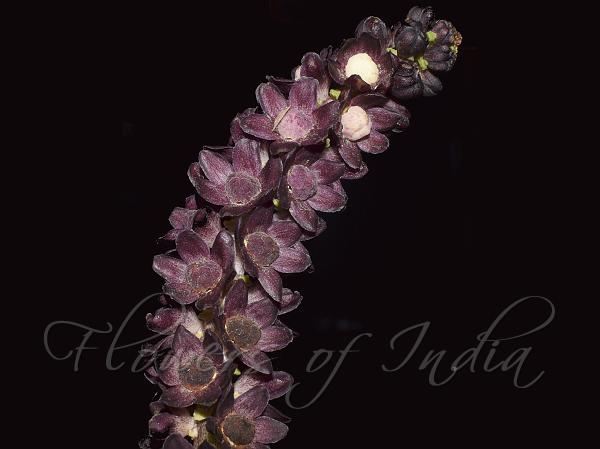|
| East-Himalayan Tupistra |
|

|

| File size | 365342 |
| Original date | 10/3/18 9:51 AM |
| Resolution | 2048 x 1536 |
| Flash | Flash fired, return detected, auto |
| Focal length | 18.0mm |
| Exposure time | 1/60s |
| Aperture | 8.0 |
| Focus Distance | |
| Metering Mode | Multi-segment |
| Camera make | NIKON CORPORATION |
| Camera model | NIKON D3300 |
| Sensor type | OneChipColorArea |
|
|
|
|
Photo: |
Botanical name: Tupistra stoliczana Family: Asparagaceae (Asparagus family)
Synonyms: Tupistra veratrifolia, Tupistra ashihoi,
Synonyms: Tupistra veratrifolia, Tupistra ashihoi,
East-Himalayan Tupistra is a perennial herb with
rhizome long, erect, or rising up, branching, thick and stout, brown,
about 21 cm long, about 3 cm in diameter. Roots are whitish to light
brown, branching, forming a fibrous network. Stem is erect, very short,
1-2 cm tall, covered with leaf sheaths. Leaves are annually 1, basal,
distinctly stalked; leaf-stalk straight, rigid, channelled, 0.5-1.3 cm
in diameter, about 41 cm long; leaf blade leathery, dark green, glossy,
elliptic to broadly elliptic, pointed at tip, gradually tapering to the
base, about 70 cm long, about 16 cm wide. Flower-cluster-stalk arise in
leaf-axils, erect, about 21 cm long, round, 3-5 mm in diameter.
Inflorescence is at branch-ends, many-flowered, about 16 cm long, 3 cm
in diameter. Floral bracts are rhomboid, about 4 × 3 mm, greenish.
Flowers are densely arranged, stalkless, dark dirty purplish to almost
black, bell-shaped, broadly opening, about 12 mm across, perianth is
about 1 cm long, very fleshy, proximally fused for about half of the
length, tube 5 mm long, segments ovate, blunt, 6 mm long. Ripening
fruits are spherical, 3-3.5 cm across, hairless, dark creamy white,
berry-like, 2-seeded. East-Himalayan Tupistra is found in East
Himalaya, from Assam and Arunachal Pradesh to Myanmar and Thailand, at
altitudes of 80-300 m. Flowering: September-October.
| Identification credit: Dipankar Borah | Photographed in Pasighat, Arunachal Pradesh & Sonitpur, Assam. |
• Is this flower misidentified? If yes,